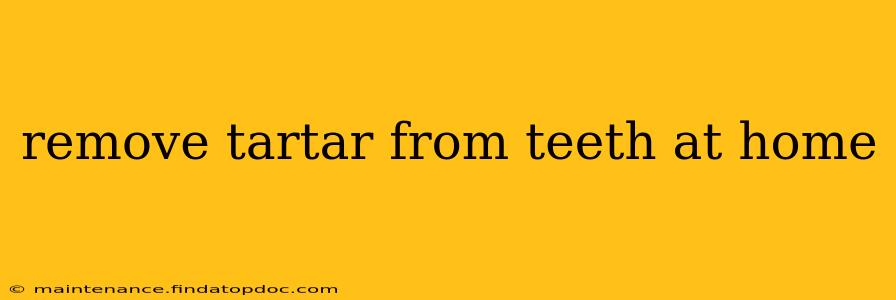Tartar, also known as calculus, is hardened plaque that builds up on your teeth. While regular brushing and flossing prevent plaque from turning into tartar, it's a stubborn substance that requires more than just a toothbrush to remove. This comprehensive guide explores effective at-home methods to tackle tartar buildup, emphasizing that while these methods can help, they aren't a replacement for professional dental cleaning.
What is Tartar and Why is it a Problem?
Tartar is plaque that has mineralized, becoming hard and difficult to remove with just brushing. It clings tightly to the teeth, creating a rough surface that attracts more plaque and bacteria. This leads to several oral health problems:
- Gum disease (gingivitis and periodontitis): Tartar irritates the gums, causing inflammation, bleeding, and potentially leading to gum recession and bone loss.
- Bad breath (halitosis): The bacteria trapped beneath tartar contribute significantly to unpleasant breath odor.
- Cavities: The rough surface of tartar provides a haven for bacteria that cause tooth decay.
- Tooth staining: Tartar can stain teeth, making them appear yellow or brown.
Can I Remove Tartar at Home?
While you can't completely remove hardened tartar at home, you can take steps to prevent its formation and remove some early-stage, less mineralized plaque that might be mistaken for tartar. The methods below focus on slowing down the build-up and addressing the milder forms of plaque. Remember, professional cleaning is crucial for removing substantial tartar buildup.
How to Prevent Tartar Buildup
Prevention is key! Here's how to minimize tartar formation:
- Brush thoroughly twice a day: Use a soft-bristled toothbrush and fluoride toothpaste. Focus on the gum line, where tartar tends to accumulate.
- Floss daily: Flossing removes plaque and food particles from between teeth, areas your toothbrush can't reach.
- Use an antimicrobial mouthwash: Mouthwashes containing chlorhexidine or essential oils can help control bacteria and reduce plaque buildup.
- Maintain a healthy diet: Limit sugary and acidic foods and drinks, as they contribute to plaque formation.
- Regular dental checkups: Professional cleanings remove tartar and plaque, preventing serious oral health problems.
At-Home Methods to Address Early-Stage Plaque (Not Hardened Tartar)
These techniques can help remove soft plaque, which is the precursor to tartar. They are not effective against hardened tartar.
- Oil Pulling: Swishing oil (such as coconut or sesame oil) in your mouth for 10-20 minutes can purportedly help reduce plaque. However, scientific evidence supporting its effectiveness is limited.
- Baking Soda: Baking soda's abrasive nature can help gently scrub away surface stains and soft plaque. Mix a small amount of baking soda with water to create a paste, and gently brush your teeth. Don't overuse this method, as it can be abrasive over time.
- Hydrogen Peroxide: Hydrogen peroxide has mild antiseptic properties and can help whiten teeth slightly. Dilute hydrogen peroxide (3%) with water and use it as a rinse. Avoid swallowing it. Again, don't overuse.
What About Tartar Removal Tools?
Various tools are marketed for at-home tartar removal. These often include specialized toothpicks or scrapers. While some might remove superficial plaque, they should be used with extreme caution and are not a substitute for professional cleaning. Improper use can damage your gums and enamel.
How Often Should I Get My Teeth Professionally Cleaned?
The American Dental Association (ADA) recommends professional dental cleanings every six months. This allows a dentist or hygienist to remove tartar and plaque effectively, preventing more serious oral health issues.
Can I Remove Tartar With Vinegar?
While some claim vinegar can remove tartar, its acidity can damage tooth enamel. Avoid using vinegar to clean your teeth.
Does Using a Water Flosser Remove Tartar?
Water flossers are excellent for removing food particles and plaque from between teeth and along the gum line. However, they do not remove hardened tartar.
Conclusion
While at-home methods can play a role in preventing tartar buildup and addressing early-stage plaque, they cannot replace professional dental cleanings. Regular brushing, flossing, and dental checkups are crucial for maintaining good oral hygiene and preventing serious dental problems. If you notice tartar buildup, schedule an appointment with your dentist for a professional cleaning.
